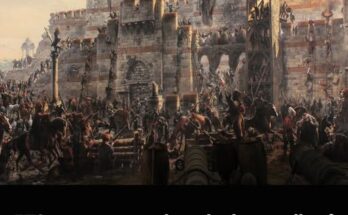In the cold streets of Amsterdam during the winter of 1944–45, a nine-year-old boy walked quietly with a spoon tucked into his coat pocket. It wasn’t just a utensil. It was hope. It was preparedness. It was a symbol of a generation of Dutch children who had learned to live with emptiness — not just in their bellies, but in their world.
The Dutch Famine, remembered bitterly as the “Hongerwinter” or “Hunger Winter,” came after the Nazis cut off food supplies to the western Netherlands in retaliation for a railway strike supporting the Allies. With canals frozen and transportation halted, the region descended into starvation. Over 20,000 people died from hunger and cold. But beyond the statistics were children like this unnamed boy, whose days were shaped by desperation, yet whose spirit remained quietly unbroken.
He carried that spoon wherever he went — to the bakeries with empty shelves, to soup lines that sometimes never formed, to the street corners where rumors of potatoes whispered through crowds like wind. To carry a spoon was to be ready for the smallest act of mercy: a stranger sharing soup, a relief worker passing out watery porridge, a neighbor offering scraps. Sometimes, the spoon stayed unused for days. But it stayed in his pocket anyway — because in a world where everything could be taken, the spoon was his to keep.
Children ate tulip bulbs and sugar beets. They scraped the insides of pans. Some chewed on leather belts or furniture glue. The boy learned not to cry about hunger because his mother’s eyes were already sunken with grief, and his father’s hands were too thin to hold anger anymore. But the boy with the spoon still dreamed — of buttered bread, of warm kitchens, of a life before war.
And when liberation finally came in May 1945, the spoon was still there. A small, dented thing — cold, metal, worn smooth from the boy’s hand. It had outlasted the famine, the fear, and the long nights. In time, he would grow older, but he would never forget that winter. The silence of the streets. The empty bowls. The way the city smelled of burning furniture instead of food.
The boy’s name may be lost to history, but his story — and the stories of thousands like him — live on in museums, in photos, in family memories. The Hunger Winter was a time of unimaginable suffering. But it also revealed the quiet strength of children — and the haunting image of a spoon, tucked into a pocket, just in case.


